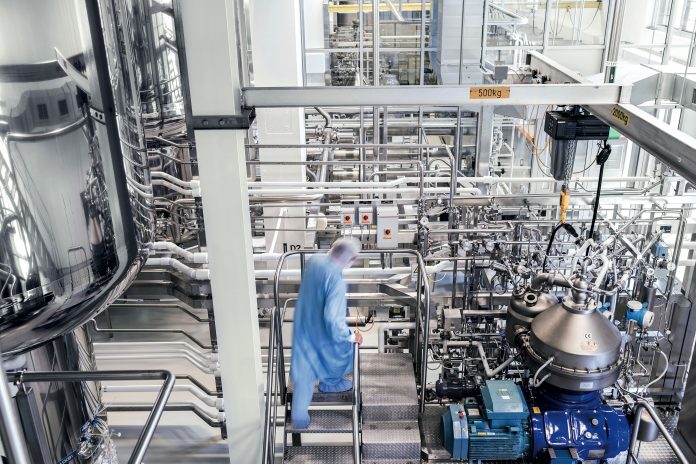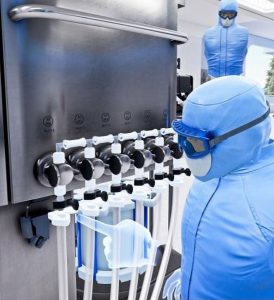
For contract manufacturing and development organizations (CDMOs), the fourth industrial revolution is well underway. Many CDMOs have already embraced digital manufacturing. That is, they have started using “smart,” automated bioprocessing technologies to monitor, model, and control processes. Initially, CDMOs implemented digital manufacturing to reduce costs and improve product quality. Now, however, CDMOs are beginning to use digital manufacturing more creatively.
We’ll get to the creative side of digital manufacturing shortly. But first, let’s dwell on the cost and quality issues. These still preoccupy many CDMOs.
Consider the results of two recent surveys. The first survey was described recently in an article by Frank Lesmeister, PhD, and Parijat Ghosh, two Bain & Company executives.1 According to this survey, respondents expected that using digital manufacturing methods instead of traditional methods would “produce total savings of 20% or more.”
“Pharma executives expect smart connected factories [to improve] quality and [make] deliveries more reliable,” the article noted. “Specifically, they forecast a 17% reduction of costs related to poor quality, a 15% decline in the cost of converting raw materials into drugs, and a 14% increase in delivery reliability.”
Lesmeister told GEN that these views about the potential savings apply industry wide. “Within our sample,” he detailed, “75% were pharmaceutical companies, and 25% were CDMOs. Also, 50% were companies with revenues over $5 billion, 35% were companies with revenues between $2 billion and $5 billion, and 15% were companies with revenues under $2 billion. We did not see significant differences within the answers across these groups.”
The second survey was conducted by a team of consultants based in Norway. These consultants also found that product quality was a major driver of CDMO investments in digital manufacturing.2 In a recent paper, the consultants offered the following observations: “Digitalization … should be tightly related to the main aspects of Good Manufacture Practice (GMP). … Close collaboration with constantly changing stakeholders is another important factor which should be in focus during digitalization.”
Both surveys, then, emphasized the importance of cost reductions and quality improvements. However, these surveys also hinted that digital manufacturing offers additional advantages, many of which come down to flexibility. For example, CDMOs that adopt digital manufacturing can build supply chains that are more resilient, production facilities that are better able to cope with fast-changing capacity requirements, and business relationships that are more collaborative.
The idea is that CDMOs that use digital manufacturing will find various ways to enhance their competitiveness. Currently, CDMOs are focusing on cost and quality. However, once these issues are addressed, CDMOs will begin focusing on the development of increasingly elaborate value propositions.
Technology transfer 4.0
For Lonza, digital manufacturing promises to improve technology transfer, which is, according to BIO, the transfer of scientific findings from one organization to another for the purpose of furthering development and commercialization. In the biopharmaceutical industry, technology transfers typically shift production from a drug sponsor to a CDMO.
“Contract development and manufacturing represents a competitive industry,” says Stephan Rosenberger, PhD, head of digital transformation group operations, Lonza. “With this in mind, we aim to be the best in class in manufacturing and technology transfers. We have invested in technologies to streamline technology transfers and operational efficiencies that improve information management, which pays dividends in time spent on problem resolution and nimble product optimization projects.
“Lonza also focuses on effective training strategies that are faster, more intuitive, and demonstrated to be more effective in meeting ‘right first time’ expectations. Overall, the Industry 4.0 focus allows us to build a comprehensive end-to-end offering that ultimately improves the speed and efficiency for the submission of therapeutics.”
Efficiency 4.0
A desire for manufacturing efficiency is also a driver according to Rosenberger, who says gaining process knowledge and using that information to optimize processes with an eye toward controlling Critical Quality Attributes (CQAs) has been a major motivation.
“The key driver in manufacturing is the efficiency gained through process knowledge,” Rosenberger explains. “Process Analytical Technology (PAT) is one important element in Lonza’s effort to further improve process control and ensure that our customers meet their own milestones.
“Within the last few years, Lonza has made considerable investments in state-of-the-art technologies aimed at enhancing the throughput of our processes and facilities. We have hired many data scientists, engineers, statisticians, and other specialists across our global network to support new technologies and the expectations connected to them.”
Connectivity 4.0
The ability to connect production activities to a customer’s changing supply chain needs is emphasized by Chris Demers, PhD, principal automation and data scientist, Catalent Pharma Solutions. “Catalent is investing significantly in Industry 4.0,” he says. “The company’s strategy is to use real-time data to run the business through the creation of a connected enterprise. For connectivity, it plans to leverage Industry 4.0 and Industrial Internet of Things (IIoT) methodologies and protocols such as Message Queue Telemetry Transport (MQTT).
“At the same time, Catalent is investing in closed-loop feedback control systems that operate at the shop-floor level and incorporate Raman spectroscopy systems and other forms of PAT. Also, Catalent is piloting machine learning and artificial intelligence (AI) tools to help its facilities move further toward a more predictive mode of operations through partnerships.”
According to Demers, Catalent’s use of Industry 4.0 technology is ultimately about satisfying customer demand, particularly with respect to the need for real-time access to manufacturing data.
“Building out a connected enterprise, characteristic of Industry 4.0, enables the company to have a single source of truth for all business data,” Demers remarks. “It enables Catalent to leverage real-time data from all the layers of the business to help facilities run more efficiently. Combined with PAT, it means consistently providing high-quality products for Catalent’s clients and ultimately for patients, and potentially [doing so] faster than ever before.”
Customer 4.0
But customer demand is impacting the CDMO sector’s move toward digital production in other ways. For some contractors, being able to offer the most advanced production technologies to their customers is a core part of their competitive strategy.
“We proactively seek out information and demand from the market to ensure we are keeping up with the latest technology trends,” Rosenberger relates. “Lonza works with a broad spectrum of companies, including large pharmaceutical companies, small and emerging biotechnology companies, or even virtual companies.

“Our customer-centric offering relies on close collaboration with our partners. This means that we also keep up with regulatory bodies to ensure we develop in key areas and work closely with customers to develop technologies relevant to their specific processes and needs.”
To that end, Lonza has established a structure to identify, prove, and deploy new technologies. “We have several projects underway to advance process understanding, new process control strategies, and process/product information management,” Rosenberger notes. “We also address the often-overlooked streamlining of critical training.”
For Catalent, the focus is about having the right technology and infrastructure to meet customer needs. “As a CDMO, we see that our customers typically look for features that are characteristic of the level of digital maturity afforded by Industry 4.0 technologies,” Demers points out. “They are not particularly concerned with the specifics, just that we deliver a solution with the features they require.”
“One of the most frequently requested features right now is real-time access to data,” he adds. “There are lots of solutions and architectures that can enable this, but it also requires a significant amount of infrastructure in connecting all the equipment at the shop-floor level. Sometimes it even requires the digitization of paper-based systems.”
Suppliers 4.0
The changing CDMO sector attitudes toward digitization have not gone unnoticed in the technology supply sector. For Pennsylvania-based technology and services firm Avantor, improving customer access to manufacturing data is another reason CDMOs are moving toward bioprocessing-oriented Industry 4.0 technology, that is, toward Bioprocessing 4.0 technology.
“Avantor has embraced the principles of Bioprocessing 4.0 to enable our customers to use the tools to increase digitization to connect products, process, and supply chains,” says Nandu Deorkar, PhD, vice president of R&D and biopharma bioproduction, Avantor. “For example, we have developed products such as single-use assemblies with sensors and raw material delivery platforms. We also have adopted electronic data transfer protocols to provide raw material data for integrated data management, analytics, modeling, and automation.”
Enhancing interoperability is likely to be a priority for CDMOs. However, interoperability is one of the biggest challenges in digital manufacturing. “A general hurdle across all manufacturing operations is connectivity. [To clear this hurdle, we must adopt] connectivity standards, such as the open platform communications unified architecture,” Demers stresses. “A small part of this is being addressed by industry consortia, but it permeates through almost every system that Catalent purchases.
“Often, the end user must contract out connectivity to systems integrators. In addition, end users may need to buy costly middleware to ‘unlock’ equipment communications. There is an opportunity for vendors to provide companies like Catalent with systems that can easily integrate into industrial supervisory control and data acquisition (SCADA) systems. This would undoubtedly speed implementation times and ease the adoption of new equipment.”
References
1. Lesmeister F, Ghosh P. Digital Manufacturing Is (Finally) Coming to Pharma. Published April 8, 2020. Accessed March 8, 2022.
2. Hole G, Hole AS, McFalone-Shaw I. Digitalization in pharmaceutical industry: What to focus on under the digital implementation process? Int. J. Pharm. X 2021; 3: 100095. DOI: 10.1016/j.ijpx.2021.100095.




